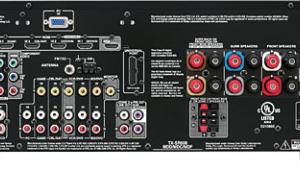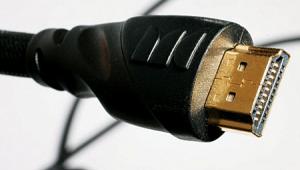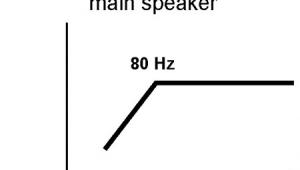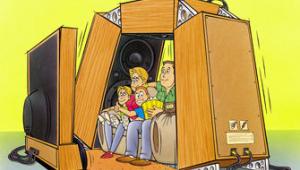THX ULTRA: Episode 2 Listening Strikes Back part 2
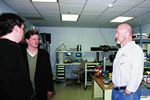 One of the significant additions with the Ultra 2 certification involves surround processing and the surround-speaker configuration. Surround EX soundtracks and multichannel music have created numerous variables for consumers to consider. The Surround EX processing mode is, of course, best used with EX-encoded software; however, the software is rarely labeled as such, nor does it always contain the data flag that's supposed to automatically switch the processor. Leaving the processor in the Surround EX mode may or may not be beneficial for non-EX 5.1 recordings. By the same token, playing 5.1-channel music formats through a 7.1 speaker system makes for some interesting channel-assignment choices, especially if you prefer dipole surround speakers for movie soundtracks and direct-radiating speakers for 5.1 music. (See our opinion of this topic in our April 2000 issue. The article is available online at www.hometheatermag.com.)
One of the significant additions with the Ultra 2 certification involves surround processing and the surround-speaker configuration. Surround EX soundtracks and multichannel music have created numerous variables for consumers to consider. The Surround EX processing mode is, of course, best used with EX-encoded software; however, the software is rarely labeled as such, nor does it always contain the data flag that's supposed to automatically switch the processor. Leaving the processor in the Surround EX mode may or may not be beneficial for non-EX 5.1 recordings. By the same token, playing 5.1-channel music formats through a 7.1 speaker system makes for some interesting channel-assignment choices, especially if you prefer dipole surround speakers for movie soundtracks and direct-radiating speakers for 5.1 music. (See our opinion of this topic in our April 2000 issue. The article is available online at www.hometheatermag.com.) 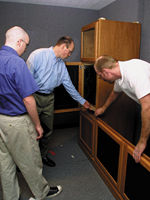 THX has developed what they feel is a single approach that allows for simpler system operation and better performance in all cases. For one, THX recommends a 7.1 speaker layout that still includes two dipole speakers to the sides of the listener but recommends two closely spaced, direct-radiating speakers in the back. THX prefers two monopole back speakers in order to preserve the discrete surrounds of multichannel music and EX/ES soundtracks. The close proximity of the two speakers also preserves a stable central image for both on- and off-axis listeners, while the THX processor applies new spacializing effects (called ASA, for Advanced Speaker Array) to create a wider soundstage than the placement would suggest.
THX has developed what they feel is a single approach that allows for simpler system operation and better performance in all cases. For one, THX recommends a 7.1 speaker layout that still includes two dipole speakers to the sides of the listener but recommends two closely spaced, direct-radiating speakers in the back. THX prefers two monopole back speakers in order to preserve the discrete surrounds of multichannel music and EX/ES soundtracks. The close proximity of the two speakers also preserves a stable central image for both on- and off-axis listeners, while the THX processor applies new spacializing effects (called ASA, for Advanced Speaker Array) to create a wider soundstage than the placement would suggest.
The ASA processing is a part of the controller's THX Ultra 2 Cinema mode, which goes beyond THX's former Re-EQ, timbre-matching, and decorrelation techniques. For starters, the Ultra 2 Cinema mode automatically detects the Surround EX flag, if present, and decodes the signal appropriately. For nonflagged Surround EX material and essentially all other 5.1 movie and music soundtracks, the processor first determines if the soundtrack is stereo or monophonic. Ultra 2 reads stereo surround information as ambience and sends it to the side dipoles, which creates the necessary diffuse soundfield. This same information then goes through the ASA processing before it's also sent to the two back surround speakers. Between the back-speaker configuration and the processing applied, directional effects should be preserved, but a wider image should be created. Mono signals that are part of a stereo surround soundtrack are interpreted as directional effects and played, unprocessed, through the back speakers. A 5.1 soundtrack, or the portion of it that contains mostly mono surround information (or the mono surround track of a 4.0 recording), is decorrelated and directed to the two side surround speakers. It's also sent unprocessed to the two back surround speakers. The result is said to be a system with what Laurie calls a "horseshoe effect," providing both ambience and directional qualities that are equally matched for both music and movie listening for a wide arrangement of listeners.
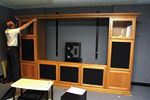 Between the changes to the front-speaker directivity, surround-speaker configuration, and surround processing, THX has more than just updated their original specification. THX Ultra 2 is a radical overhaul. There are numerous other changes that we haven't even mentioned, which basically amount to tighter tolerances for previously required performance characteristics. Overall, THX seems to have taken a noble approach to provide consumers with a system that works as well for movies as it does for music.—Mike Wood
Between the changes to the front-speaker directivity, surround-speaker configuration, and surround processing, THX has more than just updated their original specification. THX Ultra 2 is a radical overhaul. There are numerous other changes that we haven't even mentioned, which basically amount to tighter tolerances for previously required performance characteristics. Overall, THX seems to have taken a noble approach to provide consumers with a system that works as well for movies as it does for music.—Mike Wood
Like THX, Snell has spent a considerable amount of time analyzing home theater realities—like the placement of speakers where they look good but don't necessarily sound good. As we set up this Ultra 2 system, it seemed like a prime opportunity to pick the brain of Snell president and chief engineer David Smith on the key home theater issue of cabinet mounting. He outlined some critical considerations:
• Boundary effects are greater than with free-space mounting
• The cavity the speaker is mounted in has resonance based on its dimensions
• Cabinets can rattle and have panel resonance
• Cabinet mounting may make it impossible to aim the speaker toward the listener
• Doors and grilles over the speakers can block the drivers
• Perforated screens considerably reduce the upper treble
• Perforated screens cause reflections that bounce back off the surface of the speaker, leading to comb filtering
That said, Smith is adamant that cabinet mounting, when done with care, doesn't have to compromise the sound nearly as much as we think. Luckily, we had the significant advantage of working with a cabinet, the WTV-3 from ImageCrafters, that was engineered specifically for home theater by a firm that's been doing this for 20 years. Simple logic is the best approach: Good connections in the cabinet assembly lead to as solid a structure as possible. Smith also recommends experimenting with foam strips or felt discs between adjoining surfaces to quiet rattles.
We lined all sides of the left and right speaker compartments with multiple layers of foam treatment to deal with cavity effects (including resonance in the 200- to 400-hertz range). Even with the XA1900THX's boundary switch, some extra help never hurts. The smartly designed wood-frame/cloth-grille doors left no obstructions in the way of the drivers—especially important for tweeters and midranges.
We placed the center channel in the open cavity of the cabinet's interior, behind a 6-foot, micro-perforated Stewart screen. The XA1900THX has a treble switch to deal with the 3-decibel drop at 10 kilohertz and the 5-dB drop at 15 kHz that result from the average screen, but we also added a 0.5-inch piece of foam to the front baffle to handle the comb filtering that results from reflections bouncing back off the screen. Experimentation with and without the foam produced a noticeable, albeit subtle, difference.
For more information, visit the Snell Website (www.snellacoustics.com) and the ImageCrafters Website (www.imagecraftersinc.com). Play around with ImageCrafters' build-your-own-cabinet feature, which allows you to create your own cabinet system and submit it for construction.—CL
- Log in or register to post comments
